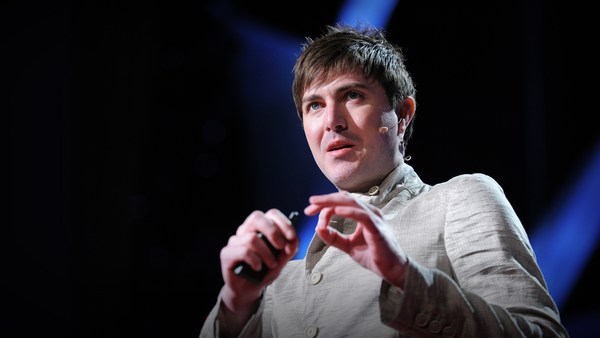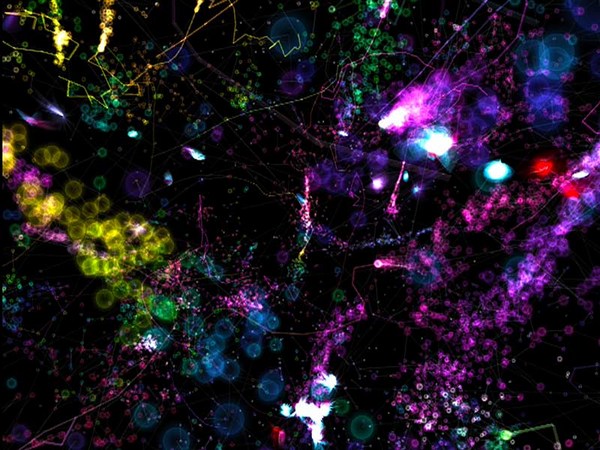My title: "Queerer than we can suppose: the strangeness of science." "Queerer than we can suppose" comes from J.B.S. Haldane, the famous biologist, who said, "Now, my own suspicion is that the universe is not only queerer than we suppose, but queerer than we can suppose. I suspect that there are more things in heaven and earth than are dreamed of, or can be dreamed of, in any philosophy." Richard Feynman compared the accuracy of quantum theories -- experimental predictions -- to specifying the width of North America to within one hair's breadth of accuracy. This means that quantum theory has got to be, in some sense, true. Yet the assumptions that quantum theory needs to make in order to deliver those predictions are so mysterious that even Feynman himself was moved to remark, "If you think you understand quantum theory, you don't understand quantum theory."
It's so queer that physicists resort to one or another paradoxical interpretation of it. David Deutsch, who's talking here, in "The Fabric of Reality," embraces the many-worlds interpretation of quantum theory, because the worst that you can say about it is that it's preposterously wasteful. It postulates a vast and rapidly growing number of universes existing in parallel, mutually undetectable, except through the narrow porthole of quantum mechanical experiments. And that's Richard Feynman.
The biologist Lewis Wolpert believes that the queerness of modern physics is just an extreme example. Science, as opposed to technology, does violence to common sense. Every time you drink a glass of water, he points out, the odds are that you will imbibe at least one molecule that passed through the bladder of Oliver Cromwell. (Laughter) It's just elementary probability theory.
(Laughter)
The number of molecules per glassful is hugely greater than the number of glassfuls, or bladdersful, in the world. And of course, there's nothing special about Cromwell or bladders -- you have just breathed in a nitrogen atom that passed through the right lung of the third iguanodon to the left of the tall cycad tree.
"Queerer than we can suppose." What is it that makes us capable of supposing anything, and does this tell us anything about what we can suppose? Are there things about the universe that will be forever beyond our grasp, but not beyond the grasp of some superior intelligence? Are there things about the universe that are, in principle, ungraspable by any mind, however superior? The history of science has been one long series of violent brainstorms, as successive generations have come to terms with increasing levels of queerness in the universe. We're now so used to the idea that the Earth spins, rather than the Sun moves across the sky, it's hard for us to realize what a shattering mental revolution that must have been. After all, it seems obvious that the Earth is large and motionless, the Sun, small and mobile. But it's worth recalling Wittgenstein's remark on the subject: "Tell me," he asked a friend, "why do people always say it was natural for man to assume that the Sun went 'round the Earth, rather than that the Earth was rotating?" And his friend replied, "Well, obviously, because it just looks as though the Sun is going round the Earth." Wittgenstein replied, "Well, what would it have looked like if it had looked as though the Earth was rotating?"
(Laughter)
Science has taught us, against all intuition, that apparently solid things, like crystals and rocks, are really almost entirely composed of empty space. And the familiar illustration is the nucleus of an atom is a fly in the middle of a sports stadium, and the next atom is in the next sports stadium. So it would seem the hardest, solidest, densest rock is really almost entirely empty space, broken only by tiny particles so widely spaced they shouldn't count. Why, then, do rocks look and feel solid and hard and impenetrable? As an evolutionary biologist, I'd say this: our brains have evolved to help us survive within the orders of magnitude, of size and speed which our bodies operate at. We never evolved to navigate in the world of atoms. If we had, our brains probably would perceive rocks as full of empty space. Rocks feel hard and impenetrable to our hands, precisely because objects like rocks and hands cannot penetrate each other. It's therefore useful for our brains to construct notions like "solidity" and "impenetrability," because such notions help us to navigate our bodies through the middle-sized world in which we have to navigate.
Moving to the other end of the scale, our ancestors never had to navigate through the cosmos at speeds close to the speed of light. If they had, our brains would be much better at understanding Einstein. I want to give the name "Middle World" to the medium-scaled environment in which we've evolved the ability to take act -- nothing to do with "Middle Earth" -- Middle World.
(Laughter)
We are evolved denizens of Middle World, and that limits what we are capable of imagining. We find it intuitively easy to grasp ideas like, when a rabbit moves at the sort of medium velocity at which rabbits and other Middle World objects move, and hits another Middle World object like a rock, it knocks itself out.
May I introduce Major General Albert Stubblebine III, commander of military intelligence in 1983.
"...[He] stared at his wall in Arlington, Virginia, and decided to do it. As frightening as the prospect was, he was going into the next office. He stood up and moved out from behind his desk. 'What is the atom mostly made of?' he thought, 'Space.' He started walking. 'What am I mostly made of? Atoms.' He quickened his pace, almost to a jog now. 'What is the wall mostly made of?'
(Laughter)
'Atoms!' All I have to do is merge the spaces. Then, General Stubblebine banged his nose hard on the wall of his office. Stubblebine, who commanded 16,000 soldiers, was confounded by his continual failure to walk through the wall. He has no doubt that this ability will one day be a common tool in the military arsenal. Who would screw around with an army that could do that?"
That's from an article in Playboy, which I was reading the other day.
(Laughter)
I have every reason to think it's true; I was reading Playboy because I, myself, had an article in it.
(Laughter)
Unaided human intuition, schooled in Middle World, finds it hard to believe Galileo when he tells us a heavy object and a light object, air friction aside, would hit the ground at the same instant. And that's because in Middle World, air friction is always there. If we'd evolved in a vacuum, we would expect them to hit the ground simultaneously. If we were bacteria, constantly buffeted by thermal movements of molecules, it would be different. But we Middle-Worlders are too big to notice Brownian motion. In the same way, our lives are dominated by gravity, but are almost oblivious to the force of surface tension. A small insect would reverse these priorities.
Steve Grand -- he's the one on the left, Douglas Adams is on the right. Steve Grand, in his book, "Creation: Life and How to Make It," is positively scathing about our preoccupation with matter itself. We have this tendency to think that only solid, material things are really things at all. Waves of electromagnetic fluctuation in a vacuum seem unreal. Victorians thought the waves had to be waves in some material medium: the ether. But we find real matter comforting only because we've evolved to survive in Middle World, where matter is a useful fiction. A whirlpool, for Steve Grand, is a thing with just as much reality as a rock.
In a desert plain in Tanzania, in the shadow of the volcano Ol Doinyo Lengai, there's a dune made of volcanic ash. The beautiful thing is that it moves bodily. It's what's technically known as a "barchan," and the entire dune walks across the desert in a westerly direction at a speed of about 17 meters per year. It retains its crescent shape and moves in the direction of the horns. What happens is that the wind blows the sand up the shallow slope on the other side, and then, as each sand grain hits the top of the ridge, it cascades down on the inside of the crescent, and so the whole horn-shaped dune moves. Steve Grand points out that you and I are, ourselves, more like a wave than a permanent thing. He invites us, the reader, to think of an experience from your childhood, something you remember clearly, something you can see, feel, maybe even smell, as if you were really there. After all, you really were there at the time, weren't you? How else would you remember it? But here is the bombshell: You weren't there. Not a single atom that is in your body today was there when that event took place. Matter flows from place to place and momentarily comes together to be you. Whatever you are, therefore, you are not the stuff of which you are made. If that doesn't make the hair stand up on the back of your neck, read it again until it does, because it is important.
So "really" isn't a word that we should use with simple confidence. If a neutrino had a brain, which it evolved in neutrino-sized ancestors, it would say that rocks really do consist of empty space. We have brains that evolved in medium-sized ancestors which couldn't walk through rocks. "Really," for an animal, is whatever its brain needs it to be in order to assist its survival. And because different species live in different worlds, there will be a discomforting variety of "reallys." What we see of the real world is not the unvarnished world, but a model of the world, regulated and adjusted by sense data, but constructed so it's useful for dealing with the real world.
The nature of the model depends on the kind of animal we are. A flying animal needs a different kind of model from a walking, climbing or swimming animal. A monkey's brain must have software capable of simulating a three-dimensional world of branches and trunks. A mole's software for constructing models of its world will be customized for underground use. A water strider's brain doesn't need 3D software at all, since it lives on the surface of the pond, in an Edwin Abbott flatland.
I've speculated that bats may see color with their ears. The world model that a bat needs in order to navigate through three dimensions catching insects must be pretty similar to the world model that any flying bird -- a day-flying bird like a swallow -- needs to perform the same kind of tasks. The fact that the bat uses echoes in pitch darkness to input the current variables to its model, while the swallow uses light, is incidental. Bats, I've even suggested, use perceived hues, such as red and blue, as labels, internal labels, for some useful aspect of echoes -- perhaps the acoustic texture of surfaces, furry or smooth and so on -- in the same way as swallows or indeed, we, use those perceived hues -- redness and blueness, etc. -- to label long and short wavelengths of light. There's nothing inherent about red that makes it long wavelength.
The point is that the nature of the model is governed by how it is to be used, rather than by the sensory modality involved. J.B.S. Haldane himself had something to say about animals whose world is dominated by smell. Dogs can distinguish two very similar fatty acids, extremely diluted: caprylic acid and caproic acid. The only difference, you see, is that one has an extra pair of carbon atoms in the chain. Haldane guesses that a dog would probably be able to place the acids in the order of their molecular weights by their smells, just as a man could place a number of piano wires in the order of their lengths by means of their notes. Now, there's another fatty acid, capric acid, which is just like the other two, except that it has two more carbon atoms. A dog that had never met capric acid would, perhaps, have no more trouble imagining its smell than we would have trouble imagining a trumpet, say, playing one note higher than we've heard a trumpet play before. Perhaps dogs and rhinos and other smell-oriented animals smell in color. And the argument would be exactly the same as for the bats.
Middle World -- the range of sizes and speeds which we have evolved to feel intuitively comfortable with -- is a bit like the narrow range of the electromagnetic spectrum that we see as light of various colors. We're blind to all frequencies outside that, unless we use instruments to help us. Middle World is the narrow range of reality which we judge to be normal, as opposed to the queerness of the very small, the very large and the very fast. We could make a similar scale of improbabilities; nothing is totally impossible. Miracles are just events that are extremely improbable. A marble statue could wave its hand at us; the atoms that make up its crystalline structure are all vibrating back and forth anyway. Because there are so many of them, and because there's no agreement among them in their preferred direction of movement, the marble, as we see it in Middle World, stays rock steady. But the atoms in the hand could all just happen to move the same way at the same time, and again and again. In this case, the hand would move, and we'd see it waving at us in Middle World. The odds against it, of course, are so great that if you set out writing zeros at the time of the origin of the universe, you still would not have written enough zeros to this day.
Evolution in Middle World has not equipped us to handle very improbable events; we don't live long enough. In the vastness of astronomical space and geological time, that which seems impossible in Middle World might turn out to be inevitable. One way to think about that is by counting planets. We don't know how many planets there are in the universe, but a good estimate is about 10 to the 20, or 100 billion billion. And that gives us a nice way to express our estimate of life's improbability. We could make some sort of landmark points along a spectrum of improbability, which might look like the electromagnetic spectrum we just looked at.
If life has arisen only once on any -- life could originate once per planet, could be extremely common or it could originate once per star or once per galaxy or maybe only once in the entire universe, in which case it would have to be here. And somewhere up there would be the chance that a frog would turn into a prince, and similar magical things like that. If life has arisen on only one planet in the entire universe, that planet has to be our planet, because here we are talking about it. And that means that if we want to avail ourselves of it, we're allowed to postulate chemical events in the origin of life which have a probability as low as one in 100 billion billion. I don't think we shall have to avail ourselves of that, because I suspect that life is quite common in the universe. And when I say quite common, it could still be so rare that no one island of life ever encounters another, which is a sad thought.
How shall we interpret "queerer than we can suppose?" Queerer than can in principle be supposed, or just queerer than we can suppose, given the limitations of our brain's evolutionary apprenticeship in Middle World? Could we, by training and practice, emancipate ourselves from Middle World and achieve some sort of intuitive as well as mathematical understanding of the very small and the very large? I genuinely don't know the answer. I wonder whether we might help ourselves to understand, say, quantum theory, if we brought up children to play computer games beginning in early childhood, which had a make-believe world of balls going through two slits on a screen, a world in which the strange goings-on of quantum mechanics were enlarged by the computer's make-believe, so that they became familiar on the Middle-World scale of the stream. And similarly, a relativistic computer game, in which objects on the screen manifest the Lorentz contraction, and so on, to try to get ourselves -- to get children into the way of thinking about it.
I want to end by applying the idea of Middle World to our perceptions of each other. Most scientists today subscribe to a mechanistic view of the mind: we're the way we are because our brains are wired up as they are, our hormones are the way they are. We'd be different, our characters would be different, if our neuro-anatomy and our physiological chemistry were different. But we scientists are inconsistent. If we were consistent, our response to a misbehaving person, like a child-murderer, should be something like: this unit has a faulty component; it needs repairing. That's not what we say. What we say -- and I include the most austerely mechanistic among us, which is probably me -- what we say is, "Vile monster, prison is too good for you." Or worse, we seek revenge, in all probability thereby triggering the next phase in an escalating cycle of counter-revenge, which we see, of course, all over the world today. In short, when we're thinking like academics, we regard people as elaborate and complicated machines, like computers or cars. But when we revert to being human, we behave more like Basil Fawlty, who, we remember, thrashed his car to teach it a lesson, when it wouldn't start on "Gourmet Night."
(Laughter)
The reason we personify things like cars and computers is that just as monkeys live in an arboreal world and moles live in an underground world and water striders live in a surface tension-dominated flatland, we live in a social world. We swim through a sea of people -- a social version of Middle World. We are evolved to second-guess the behavior of others by becoming brilliant, intuitive psychologists. Treating people as machines may be scientifically and philosophically accurate, but it's a cumbersome waste of time if you want to guess what this person is going to do next. The economically useful way to model a person is to treat him as a purposeful, goal-seeking agent with pleasures and pains, desires and intentions, guilt, blame-worthiness. Personification and the imputing of intentional purpose is such a brilliantly successful way to model humans, it's hardly surprising the same modeling software often seizes control when we're trying to think about entities for which it's not appropriate, like Basil Fawlty with his car or like millions of deluded people, with the universe as a whole.
(Laughter)
If the universe is queerer than we can suppose, is it just because we've been naturally selected to suppose only what we needed to suppose in order to survive in the Pleistocene of Africa? Or are our brains so versatile and expandable that we can train ourselves to break out of the box of our evolution? Or finally, are there some things in the universe so queer that no philosophy of beings, however godlike, could dream them?
Thank you very much.
(Applause)





